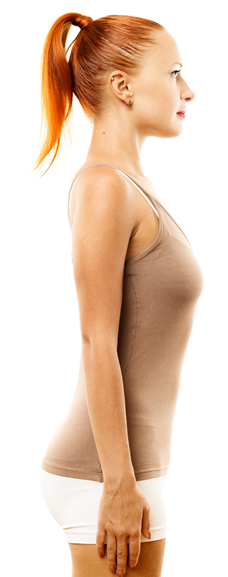When seen from the front, the spine should be straight. But when viewed from the side, the healthy spine has three gentle curves: In the neck and lower back, called lordosis; and in the chest area, called the kyphosis. But these curves can become distorted and the spinal column (and the whole skeletal structure) can become misaligned.

- Leg bones form vertical columns of support.
- Central axis or Center of gravity divides the entire body almost exactly in half.
- Weight-bearing joints (ankle, knee, hip, and shoulder) line up along the central axis.
- Pelvis and rib cage are in a natural, neutral position.
- Spine is optimally elongated.
- Muscles throughout the body are evenly balanced and elastic.
- Internal organs are positioned naturally and not compressed.
- Body is free from pain and tension.
- Examples of unnaturally aligned bodies: note how the weight-bearing joints are unstable and under constant stress.

- Leg bones are not vertical and don’t offer solid support for the body.
- The skeleton does not organize around the vertical axis.
- Weight-bearing joints are not stacked up, causing compression in the joints.
- Pelvis and rib cage are misplaced.
- Spine is contracted and shortened.
- Muscles throughout the body must be chronically contracted.
- Internal organs are ill positioned, crowded, and compressed. The body is subject to chronic tension, pain, and stiffness.
Spinal misalignment is a three-dimensional problem, creating what is often called the screw matrix effect:
Here’s an easy home-test you can do with a partner: Start in a standing position, relaxed, feet about shoulder-width apart, eyes closed. Tilt head forward and back, then side to side, the stop in the middle. Partner, check these things while looking at the subject’s posture from the front:
- Are the eyes level? To which side is the head tilting?
- Are the shoulders level? Which is higher or lower?
- Is the head centered, or is it shifted toward one side or the other? Which side?
- Are the hips level? Which side is higher or lower?
These posture red flags may go away once the patient opens his or her eyes, as a matter of pure instinct, so make note of them while you can.
Noting the subject’s posture from the side:
- Look at the hold of the ear, is it lined up over the middle of the shoulder?
- Is the middle of the shoulder lined up over the middle of the pelvis/hip?
- Is the pelvis behind the shoulders (in back of the shoulders)?
- Is the pelvis in front of the shoulders?
- The middle of knee and ankle bones should also be lined up with the pelvis.
SPINAL DEGENERATION AND SPINAL CURVATURE
Spinal degeneration is the progressive loss of spinal strength and integrity to hold the body up, protect the nerves within, and maintain good posture. Spinal degeneration is classified into four stages. Stage I is notable for a loss of curves in the spine, resulting in a slumped or slouched appearance. Stage II adds bone and disc degeneration to the condition. In Stage III, misaligned vertebrae begin to fuse together. Stage IV Spinal Degeneration is notable for the addition of surgical additions to the spine for support.
Your spine is supposed to be curved, but those curves must be healthy and stable, and your vertebrae well-aligned.
If they are, good posture is yours for a lifetime.
[button_2 color=”green” align=”center” href=”https://www.familyhealthchiropractic.com/schedule-an-appointment/”]Schedule an Appointment[/button_2]


